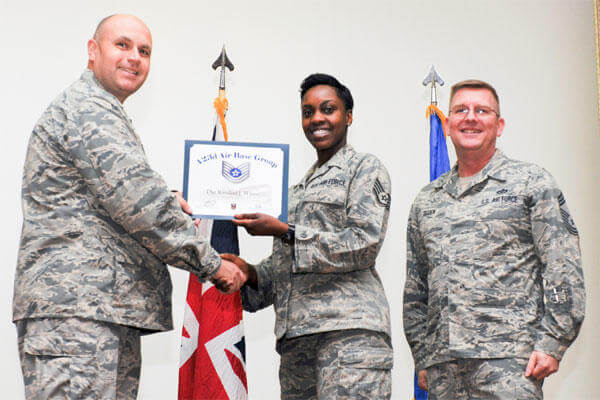Air Force enlisted members advance to pay grades E-5 through E-7 faster than they did before recent wars, but still slower than peers in every other branch of service. That dampens total earnings over a 20-year career.
The greatest career income difference tied to promotion pace is seen between Air Force and Navy enlisted because sailors show the fastest advancement rate among the four Defense of Department service branches.
Among officers, however, Air Force promotes faster than Army and Marine Corps peers through 20 years' service, and even surpasses Navy's pace over a typical 24-year officer career, service promotion data show.
The promotion-pace disparity by service for officers is smaller than for enlisted almost certainly due to tighter controls imposed by Congress.
The chart below shows average years of service at time of promotion by branch and rank for 2012, the most recent data available. When compared to data from 2000, results show promotion disparities across services have narrowed over the last dozen years of war.
In 2000, for example, Air Force enlisted made E-6 (technical sergeant) after 14.7 years, on average. That was 3.6 years slower than sailors made E-6 (petty officer first class) and more than six years slower than peers in ground forces (staff sergeant). Soldiers in 2000 advanced to E-6, on average, 8.6 years into careers and Marines at 8.3 years.
By 2012, airmen were putting on E-6 stripes after 11.1 years, more than three years faster than in 2000. Navy advancements to E-6 also jumped, by almost two and a half years. Soldiers' average time to make E-6 was trimmed by a few months since 2000, to an average of 8.2 years, while Marines saw their pace slowed a little, to 8.8 years, to be even with Navy.
Air Force enlisted members by 2012 were making E-7 in 16 years versus a 14-year average across all four services. They reached E-8 in 19.9 years versus an all-service average of 18.4. And Air Force members reached E-9 at 23.6 years, a full year later than the all-service pace to E-9.
Promotion pace for officers is slower in the ground forces. In 2012, Army and Marine Corps officers reached the rank of O-5 (lieutenant colonel) at 16.5 years, on average, compared to 14.6 years for Air Force and 14.9 years to make Navy commander. The Defense Department overall average of 15.4 years to 0-5 was very close to the average of 15.6 reported in 2000.
We asked Air Force for comment on its pace of promotions but didn't receive a reply by deadline. In the past, officials have explained the slower pace of enlisted promotions as tied to the popularity of the Air Force and quality of life it offer. Also, the service need high-tech specialists and encourages robust retention rates. A tradeoff is slower promotions.
But how does pace of promotion impact career compensation?
We developed a rough measure using Defense Department amounts for Regular Military Compensation (RMC) in 2013, and service data on years-of-service-at-promotion to calculate values for average RMC, by service, across a 20-year career for enlisted and a 24-year career for officers.
RMC equals military basic pay, plus housing and food allowance, and an estimated tax-advantage value tied to tax-exempt allowances. For our career value calculations we use average RMC by rank and years of service; actual RMC would vary by individual based on where they live and family status, which along with rank determines level of housing allowance.
In estimating the effect of promotion pace on career compensation here, we don't consider in our calculations any special pays, bonuses or other targeted incentives important for shaping an all-volunteer force. Our career RMC amounts don't include, for example, flight pay, sea pay, combat pay, reenlistment bonuses or officer retention pays, which can be hefty for pilots, physicians and nuclear-trained officers.
So what follows is a simple snapshot, by service, of career RMC values if average RMC today were frozen in time, and if the most recent data on years-of-service-at-promotion stayed constant over members' careers:
Enlisted -- Sailors at current pay levels, and based on current pace of promotion, would earn a total $1,317,415 over a 20-year career. Soldiers would earn $1,307,802, or $9,613 less over 20 years. Marines would earn a total of $1,303,965, or $13,450 less than sailors.
At the bottom, due to slower promotions, are Air Force enlisted who would earn $1,249,370 for two decades of service, $68,045 less than sailors.
Officers -- By 20 years, Navy officers would earn more than peers in any other service, a total of $2,113,428. Air Force officers are close behind at $2,110,534, followed by Army at $2,102,974. Earning $29,169 less than Navy peers at the 20-year mark are Marines at $2,084,259.
Officer careers usually are longer so we extend our RMC calculations based on promotion pace out to 24 years. By then, Air Force officers lead on total earnings at $2,748,071. Navy officers are slightly behind at $2,741,06 and Army $30,000 off the lead at $2,719,000. Marine officers over a 24-year career earn $2,695,335, or $53,000 less in total RMC than Air Force peers.
Earning totals at 24 years confirm the value for officers of sticking around past 20. Those in 0-5 rank draw average RMC worth nearly $143,000 in their 21st and 22nd year of service. O-6s draw average RMC of almost $163,000 in their 23rd and 24th year. Actual totals would be higher if officers are married and living in high-cost areas, or lower than shown if single and living in rural areas where housing allowances are more modest.
To comment, e-mail milupdate@aol.com, write to Military Update, P.O. Box 231111, Centreville, VA, 20120-1111 or visit: www.militaryupdate.com
Average Years of Service at Promotion
By Service Component and Grade
Active Duty in Fiscal 2012
|
Rank |
Air Force |
Marines |
Navy |
Army |
Total |
|
|
|
|
|
|
|
|
E-2 |
0.6 |
0.5 |
0.8 |
0.9 |
0.7 |
|
E-3 |
1.1 |
1.1 |
1.3 |
1.0 |
1.0 |
|
E-4 |
2.5 |
2.7 |
2.3 |
2.0 |
2.3 |
|
E-5 |
5.0 |
4.6 |
4.2 |
4.4 |
4.5 |
|
E-6 |
11.1 |
8.8 |
8.8 |
8.2 |
9.3 |
|
E-7 |
16.0 |
12.8 |
13.7 |
12.5 |
14.0 |
|
E-8 |
19.9 |
17.0 |
18.0 |
17.8 |
18.4 |
|
E-9 |
23.6 |
22.0 |
21.9 |
22.6 |
22.6 |
|
Chief Warrant Officer 2 |
- |
1.5 |
0.0 |
2.0 |
1.9 |
|
Chief Warrant Officer 3 |
- |
3.4 |
3.0 |
6.3 |
5.6 |
|
Chief Warrant Officer 4 |
- |
7.1 |
6.8 |
10.9 |
10.0 |
|
Chief Warrant Officer 5 |
- |
11.0 |
11.8 |
17.5 |
15.8 |
|
1st Lt / Lieutenant (JG) |
1.8 |
2.0 |
2.0 |
1.6 |
1.8 |
|
Captain / Lieutenant |
3.8 |
4.1 |
3.9 |
3.4 |
3.8 |
|
Major / Lt Commander |
9.3 |
10.1 |
9.2 |
9.3 |
9.3 |
|
Lt Colonel / Commander |
14.6 |
16.5 |
14.9 |
16.5 |
15.4 |
|
Colonel / Captain |
20.4 |
22.0 |
21.0 |
21.7 |
21.1 |
|
Brig Gen / Rear Adm (L) |
25.1 |
27.0 |
28.6 |
27.6 |
27.1 |
|
Maj Gen / Rear Adm (U) |
28.5 |
30.3 |
30.0 |
30.1 |
29.7 |
|
Lt Gen / Vice Admiral |
30.9 |
34.7 |
31.3 |
32.5 |
31.8 |
|
General / Admiral |
32.9 |
- |
34.4 |
32.3 |
33.5 |









